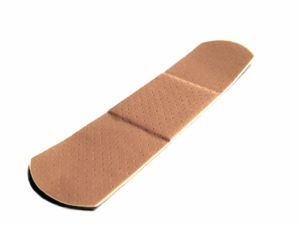With summer approaching and people spending more time outdoors and basically being more active with lawn and garden care, summer building projects and the like, the chances of suffering a minor scrape or cut is increased. Unfortunately, that means the risk of infection and other serious problems resulting from a cut is also increased.
The most important thing to keep in mind when caring for a cut is that if you are diabetic, especially if you cut your foot, you should seek medical attention. Additionally, if you have nerve damage, poor circulation, or if you have an altered immune system, you should see your physician even for the smallest cuts.
For most people, however, caring for a minor cut is easy to do. First, just because you can’t feel a cut, doesn’t mean it’s not in need of care. Minor scrapes and cuts may not cause any pain immediately, but can still become infected or cause other health problems.
The most important thing to do to care for a cut is to lightly wash the cut with soap and water. After washing the cut, be sure to dry the cut completely, using cotton or a swab to pat it dry, and then place a bandage on the cut. If it is a larger cut, wrapping the affected area loosely with light gauze can help protect the cut from becoming dirty again.
There are many antibacterial washes, soaps and creams on the market that can be used to care for a cut. However, these products truly are not necessary, because cleansing with soap and water and keeping the cut clean is usually enough to heal the cut and prevent scarring.
If you would prefer to use a medicated cream, the best choice is to use an antibiotic cream, such as Neosporin or a store brand triple antibiotic cream. These antibiotic creams can help care for cuts and reduce healing time if used properly. Do not use too much antibiotic cream. It takes a very small amount, lighting spread over the cut or around it, careful not to put any cream into a deep section of the cut or a punctured skin area.
While advertising may indicate that cuts heal faster when using these medicated creams, most reputable medical sights indicate that this is not necessarily true of all cuts.
The most important thing to consider when caring for a cut is to keep the cut clean into it scabs over or heals completely. Dirt and germs can enter a cut that has not properly healed, and bacteria can grow in a cut that is now dry – so it is important to keep cuts clean, dry, and protected while they heal.
Typically, a cut should begin to heal within three days of the cut occurring, and depending on the depth and severity of the cut, should be mostly healed within a week or two at the most. A cut that is not healing in a reasonable amount of time requires medical treatment by a licensed health care professional. Additionally, you should check the cut and change the bandage at least once every day while the cut is healing. If you notice any swelling, extreme redness or puffiness, pus, discoloration or if when you touch it the cut or area around the cut feels warm, you should seek medical attention.
Antibiotic ointments are used to prevent infection, not to cure or heal an infection. If your cut becomes infected, using an over the counter antibiotic ointment will likely not cure the infection, and therefore, a visit to a health care professional is in order if you feel your cut has become infected.
Caring for a cut is really easy, as long as you are careful to keep the cut clean and dry and lightly covered and watch for the signs of infection. Every cut, no matter how small, should be cared for in the same manner to prevent infection and causing larger problems. Keep yourself safe this summer and use the proper care when care for cuts.
